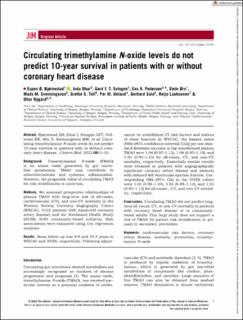Circulating trimethylamine N-oxide levels do not predict 10-year survival in patients with or without coronary heart disease
Bjørnestad, Espen Øglænd; Dhar, Indu; Svingen, Gard Frodahl Tveitevåg; Pedersen, Eva Kristine Ringdal; Ørn, Stein; Svenningsson, Mads Malm; Tell, Grethe Seppola; Ueland, Per Magne; Sulo, Gerhard; Laaksonen, Reijo; Nygård, Ottar Kjell
Journal article, Peer reviewed
Published version

Åpne
Permanent lenke
https://hdl.handle.net/11250/3031980Utgivelsesdato
2022Metadata
Vis full innførselSamlinger
- Department of Clinical Science [2317]
- Registrations from Cristin [9766]
Sammendrag
Background
Trimethylamine N-oxide (TMAO) is an amine oxide generated by gut microbial metabolism. TMAO may contribute to atherothrombosis and systemic inflammation. However, the prognostic value of circulating TMAO for risk stratification is uncertain.
Methods
We assessed prospective relationships of plasma TMAO with long-term risk of all-cause, cardiovascular (CV), and non-CV mortality in the Western Norway Coronary Angiography Cohort (WECAC; 4132 patients with suspected coronary artery disease) and the Hordaland Health Study (HUSK; 6393 community-based subjects). Risk associations were examined using Cox regression analyses.
Results
Mean follow-up was 9.8 and 10.5 years in WECAC and HUSK, respectively. Following adjustments for established CV risk factors and indices of renal function in WECAC, the hazard ratios (HRs) (95% confidence intervals [CIs]) per one standard deviation increase in log-transformed plasma TMAO were 1.04 (0.97–1.12), 1.06 (0.95–1.18), and 1.03 (0.93–1.13) for all-cause, CV, and non-CV mortality, respectively. Essentially similar results were obtained in patients with angiographically significant coronary artery disease and patients with reduced left ventricular ejection fraction. Corresponding HRs (95% CIs) in the HUSK cohort were 1.03 (0.96–1.10), 1.01 (0.89–1.13), and 1.03 (0.95–1.12) for all-cause-, CV, and non-CV mortality, respectively.
Conclusions
Circulating TMAO did not predict long-term all-cause, CV, or non-CV mortality in patients with coronary heart disease or in community-based adults. This large study does not support a role of TMAO for patient risk stratification in primary or secondary prevention.
